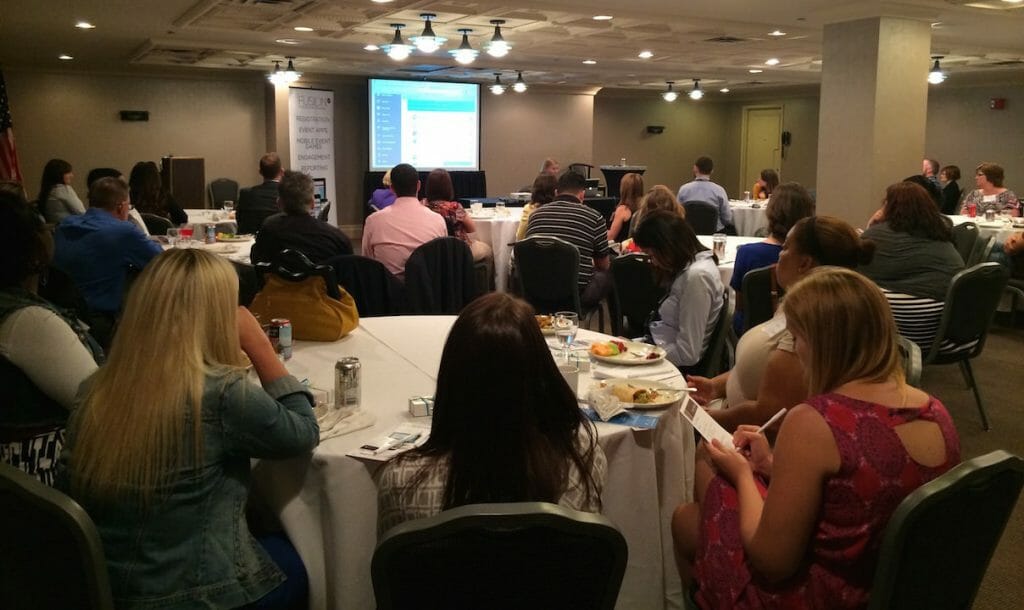B2B In-Person Events Need A Digital Makeover: Insights from Forrester Report
According to Forrester Research, CMOs invest a lot of money into conferences, trade shows, and seminars, even though it’s becoming more challenging to attract the attention of buyers using corporate events and/or get the most value out of participating in third-party conferences and trade shows. The remedy, writes Laura Ramos, the researcher behind the “B2B In-Person Events Need a Digital Makeover” report is to apply digital tactics to “turn these standalone activities into more durable marketing assets.” Here’s what she means and what CMOs can do about it.
What CMOs spend their money on: In 2015, in-person events occupied the largest line item in the marketing budget for those surveyed. When added to promotions, sponsorships, and hospitality, face-to-face interactions accounted for 21 percent of the total spend.
Why CMOs invest in events: Well over half of the CMOs surveyed, 67 percent, deploy events (buy booth space or organize their own conferences) because sales wants them to, while another 48 percent invest in sponsorships to keep up with their competitors—not because it makes sense from a business perspective.
What CMOs are doing wrong: Many head marketers (29 percent) admit to running face-to-face events in isolation, i.e. they don’t do a great job of integrating events with other marketing initiatives. Plus, only seven percent of survey respondents use event management technology “to help them collect data, measure returns, and connect event activities to business value.”
Buyers pay less attention to events: Attendees have many more ways to explore solutions than by attending in-person events. In fact, they rely more heavily on peers, websites, and analysts to make early-stage buying decisions than they do on events. Therefore, the pressure is on to plan and participate only in conferences and trade shows that deliver the best business value.
B2B Marketing Event Ideas That Leverage Digital
The good news is that it’s not too late for marketers to make the face-to-face events that they organize provide a bigger payoff. Since 2008, Forrester has advocated that integrating events into the marketing mix, investing in professional management, and using events to get closer to customers is important. But today, they also have to plan better events for more discerning buyers and extract more business value from the events they produce. And that sort of effort will rely heavily on a digital strategy.
Forrester’s Ramos recommends a number of ways that corporate event marketers can digitize events:
- Employ livestreaming, event hashtags, and live blogging to reach a broader audience.
- Incentivize social media sharing of brand messages to energize advocates.
- Rely on event-mobile apps to enrich attendee participation and engagement and collect data on participant behaviors and preferences.
- Use data collected via event management platforms to inform sales conversations.
- Deploy technologies such as iBeacon and augmented reality to personalize event experiences.
More B2B Event Strategy With Digital In Mind
There are also ways to leverage digital technology that the Forrester report didn’t mention:
- Second-screen apps allow conference session attendees to view PowerPoint presentations on a tablet and submit questions, share content, and interact with peers who are in the room or following along from a remote location.
- A live TV or internet-radio show of participant and guest interviews can add dimension and context alongside the programmed content of the conference. These distillations can be compelling and useful for prospective buyers and influencers with short attention spans.
- The repackaging of content and associated insights in the form of on-demand podcasts—an increasingly popular form of content distribution—can reach potential buyers in places that aren’t conducive to consuming text or video.
- Next-generation event management platforms not only collect data, but also provide ROI metrics and guidance around what steps event marketers should take to plan more productive events and extract even more business value from face-to-face interactions.
- Matchmaking software helps sales personnel discover and connect with more qualified buyers at events.
- Lead-qualification and appointment-setting platforms can drive leads from live interactions directly into the CRM.
The purpose of the Forrester report is “to describe how to convert these high-potential face-to-face experiences into opportunities to generate more qualified demand and more loyal customer relationships.” And to that end, the report is packed with great ideas for deploying a B2B event strategy that leverages digital technology. In the future, event-specific technologies, including event-mobile apps and event management platforms, will become better equipped and play an even larger role in helping CMOs rehab event spending.
What’s Next?
- When event planners fail to capture the true value of meetings and corporate events, event spending is perceived as discretionary and events are viewed as a “nice to have” instead of a contributor to the bottom line. Read more about the ROI Hole in Corporate Event Planning.
- What makes a marketing event successful? Find out Effective Event Marketing Tactics to Use at Your Next Event.
